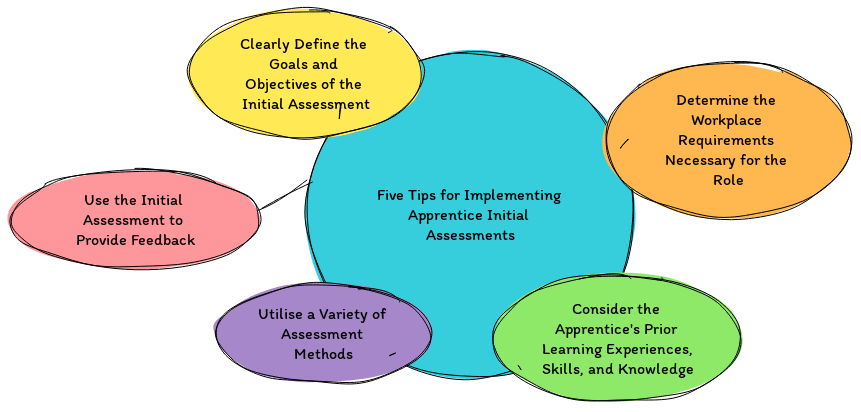This article provides detailed guidance on conducting initial assessments of apprentices and measuring their contribution to the workplace. The main focus is ensuring that apprentices learn effectively and progress towards their intended job roles or other career outcomes. Here, we present five tips for implementing apprentice initial assessments and discuss personalising the learning experience based on assessment findings.
The Importance of Initial Assessments in Apprenticeships
An initial assessment is an essential component of any apprenticeship programme. Determining a learner’s starting points enables educators to ensure that the apprentice can learn effectively and progress to their intended job roles, sustained employment, promotion, or, when appropriate, a higher level of apprenticeship or qualification.
Conducting Initial Assessments
When performing initial assessments, it is essential to consider the following factors:
- The Apprentice’s Prior Learning Experiences and Achievements: Understanding the apprentice’s educational background, previous training, and relevant certifications helps create a baseline for their current capabilities.
- The Apprentice’s Current Skills and Knowledge: Assessing current skills and knowledge ensures that the training programme is tailored to build on existing strengths and address gaps.
- The Apprentice’s Goals and Aspirations: Knowing the apprentice’s career ambitions aligns the training programme with their objectives, making the learning process more relevant and motivating.
- The Workplace Requirements for the Role: Understanding the specific demands of the job role ensures that the training programme is directly applicable to the apprentice’s work environment and future responsibilities.
By addressing these aspects, you can ensure that the initial assessment is fit for purpose and will aid the apprentice in learning effectively.
Measuring an Apprentice’s Contribution to the Workplace
Measuring an apprentice’s contribution in the workplace can be challenging. However, several key indicators can provide valuable insights:
- The Quality of Work Produced: Regular evaluations of the apprentice’s work help assess their competency and improvement over time.
- The Quantity of Work Produced: Tracking the volume of work can indicate the apprentice’s efficiency and capacity to handle the workload.
- The Apprentice’s Attitude Towards Work: Observing the apprentice’s engagement, enthusiasm, and willingness to take on new tasks can provide insights into their professional development.
- The Apprentice’s Attendance Record: Consistent attendance strongly indicates the apprentice’s commitment and reliability.
- The Apprentice’s Punctuality: Being on time demonstrates professionalism and respect for workplace norms.
These factors offer a solid indication of an apprentice’s performance and their effective contribution to the workplace.

Five Tips for Implementing Apprentice Initial Assessments
- Clearly Define the Goals and Objectives of the Initial Assessment: Align the assessment with the apprentice’s and the organisation’s goals to ensure it is purposeful and relevant.
- Consider the Apprentice’s Prior Learning Experiences, Skills, and Knowledge: It is important to understand the apprentice’s background comprehensively to tailor the training programme effectively.
- Determine the Workplace Requirements Necessary for the Role: Provide context for the assessment by aligning it with the specific demands of the apprentice’s job role.
- Utilise a Variety of Assessment Methods: Employ different assessment techniques (e.g., practical tasks, written tests, interviews) to obtain a well-rounded picture of the apprentice’s abilities.
- Use the Initial Assessment to Provide Feedback: To guide the apprentice’s development, offer constructive feedback on their progress and areas for improvement.
Personalising the Learning Experience Based on Initial Assessment Findings
Upon establishing the initial assessment findings, use this information to tailor the apprentice’s learning experience. This ensures they are best positioned to succeed in their apprenticeship and contribute effectively to their workplace. Several approaches can be employed to achieve this:
- Set Clear Expectations: Communicate the learning and development requirements clearly from the outset.
- Collaborate with Your Apprentice: Work together to identify strengths and weaknesses, focusing on improvement areas.
- Develop a Tailored Learning Plan: Create a personalised learning plan and review it regularly to monitor progress.
- Encourage Responsibility: Motivate the apprentice to set personal goals and take charge of their learning and development.
- Maintain Open Communication: Offer support and guidance while allowing the apprentice the space to grow and develop independently.
By dedicating time and effort to personalising the learning experience for your apprentice, you can be confident that they are acquiring the necessary knowledge and skills to be successful in their apprenticeship and beyond. Conducting comprehensive initial assessments and measuring their contribution in the workplace are essential steps in ensuring that apprentices are learning effectively and progressing towards their career goals. By following the guidance in this article, educators can better support their apprentices and set them on the path to a rewarding career.



